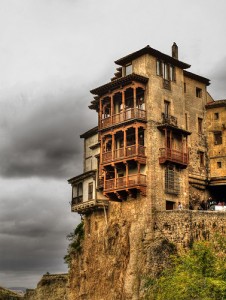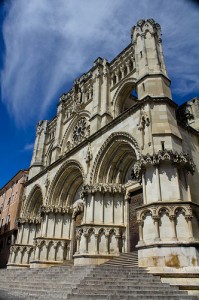Cuenca is an exceptionally well-preserved medieval fortified city, officially recognised by UNESCO as a World Heritage Site. Built by the Moors in a defensive position at the centre of Caliphate of Cordoba, it’s a site that attracts history lovers from all around the world.
The Castilians first conquered it in the 12th century, and it quickly developed as a royal town and bishopric, full of important buildings such as Spain’s first Gothic cathedral, and the legendary casas colgadas, hanging houses that teeter over the edge of the canyon. The city’s location perched on top of magnificent cliffs and overlooking the Huécar River, makes it a prime position for enjoying the beautiful views across the rolling Spanish countryside.
UNESCO World Heritage Site status
The UNESCO Committee awarded the prestigious accolade of World Heritage Site status on the grounds of Cuenca’s cultural heritage and particularly due to the preservation of its original townscape with religious and secular architecture from the 12th to 18th centuries. Unlike many sites that fail to blend architecture subtly into the surrounding landscape, Cuenca does this exceptionally well.
The history of Cuenca
Islamic in origin, Cuenca reached its heyday during the medieval and Renaissance centuries. When the Moors conquered Spain, they chose to take advantage of one of the best defensive sites in the Iberian region, building a town from which to control the nearby communities.
Over time, the town developed further and began to spread down the crest of the hill, becoming an important centre in terms of both economy and administration. Though religious institutions largely overtook the centre, wealthy residents moved to the lower parts of the town, and poorer people started to develop new suburban areas in the locality. As such, the region became very diverse with all aspects of Spain represented.
The early 17th century saw the collapse of the previously booming textile industry, which triggered an economic crisis. Only the religious aspects of the town survived relatively unscathed, and so Cuenca became a monastic centre, awash with Baroque architecture. Older buildings however started to fall into disrepair, and consequently, they were either demolished or simply collapsed. More affluent residents started to leave the area, transforming Cuenca into a predominately working class and religious region.
Cuenca as it stands today
Today, the upper town remains as the archetype of a typical fortress-town, which is largely why it attracts high levels of visitors and much acclaim in the world of history and architecture. The Castillo quarter is a small suburb just outside the walls, and leads to the old town across a bridge. Remains of the Moorish fortress can still be found, alongside the large and impressive aristocratic houses, monasteries, and churches. The 12th-century cathedral, Town Hall and Petras convent still stand to this day, and act as a reminder of the area’s strong religious history.
Visiting Cuenca
Those looking for a truly authentic experience can choose to stay in one of the converted monasteries in the centre of Cuenca. Reasonably priced and an entirely different experience from staying in a hotel, it’s highly recommended.
The area is still filled with museums, churches, and cathedrals, which can all be explored by visitors wishing to gain an insight into the area’s rich and interesting history.
Catering for the influx of tourists that Cuenca has seen in recent years, nearby facilities such as restaurants and bakeries are exceptionally good – be sure to try the brilliant egg custards! There is also a good selection of local shops, selling everything from souvenirs to handmade clothing.
Conclusion
Cuenca is a fascinating destination for tourists, checkout deals available at First Choice Holidays. Offering an insight into a side of Spain that is unknown to many, it provides plenty in the way of culture and history. Why not take a trip and discover it for yourself?
An article by travel blogger Matt Scott.
Image credits:



